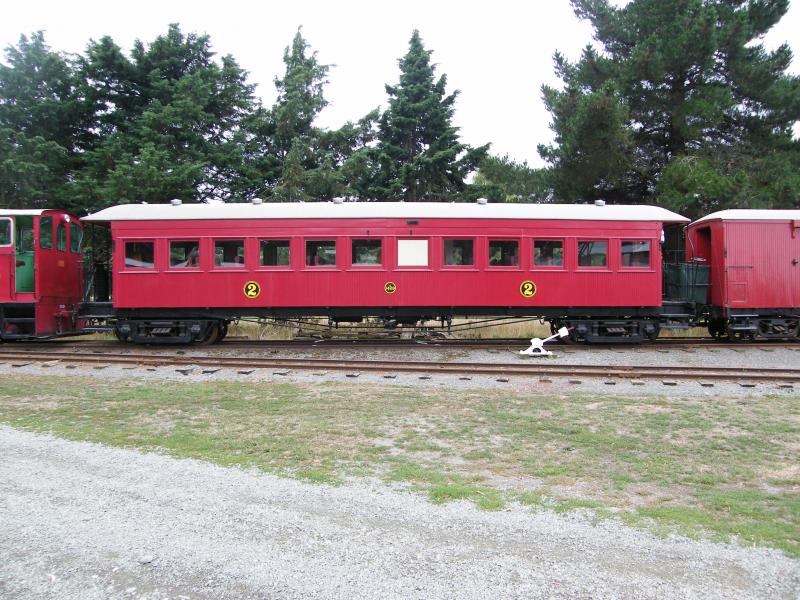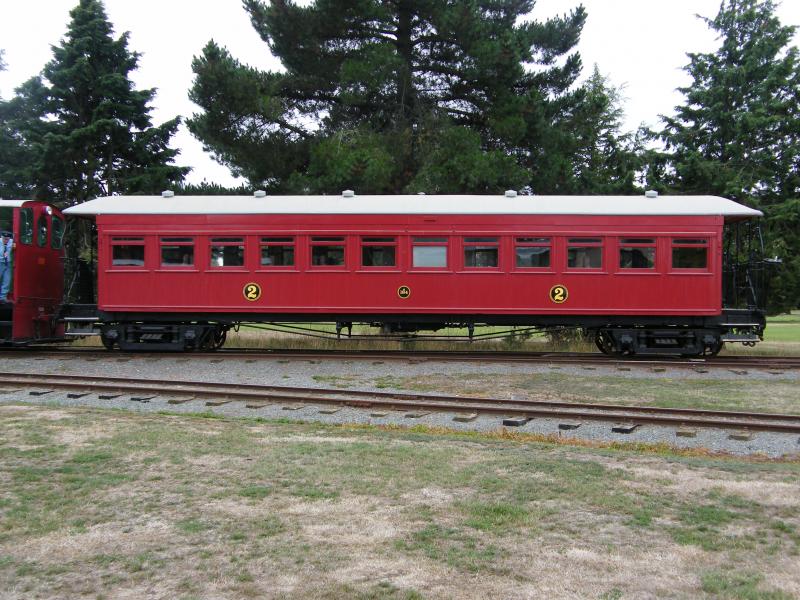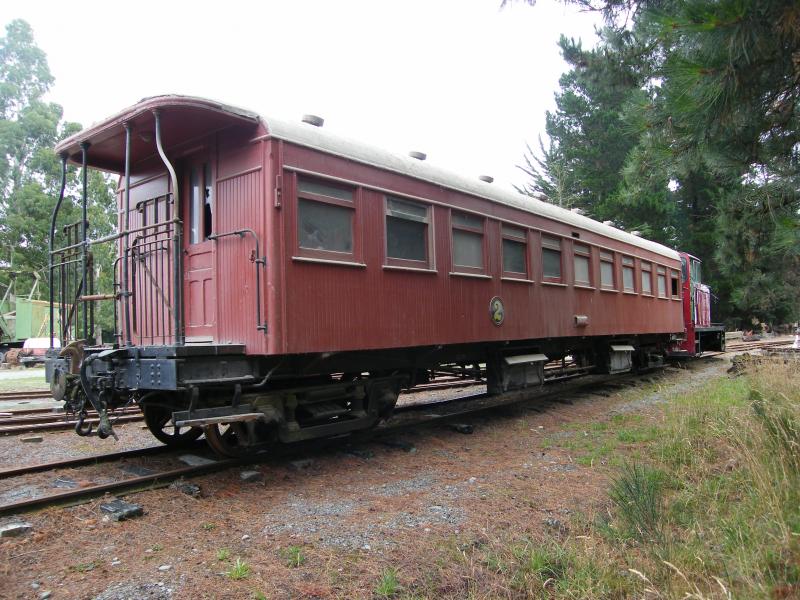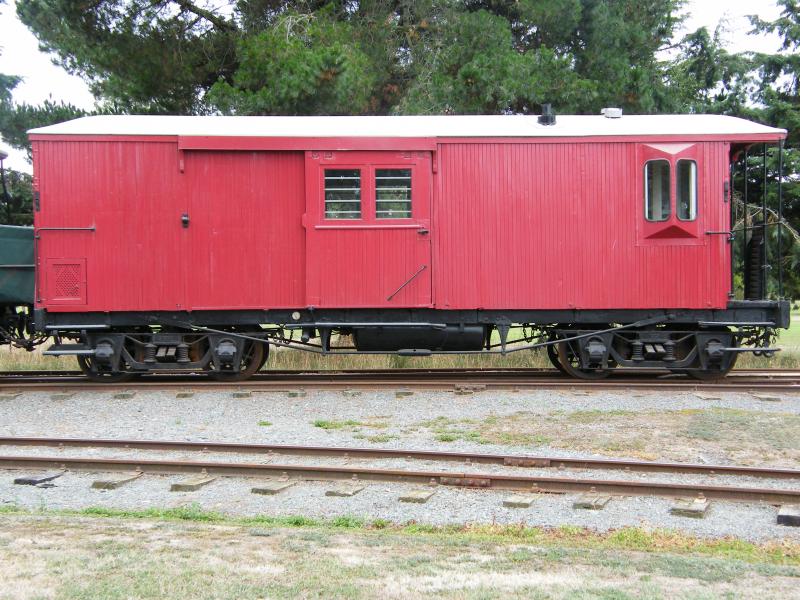A 1429 – Addington Workshops
Carriage ‘A’ 1429 entered service on 30/10/1915 once construction was completed at Addington Workshops, Christchurch.
It was originally allocated to the Invercargill section, and is 47ft 6in long. Like A 184 it is split into two compartments separated by a centre lavatory. These compartments were originally fitted with 26 and 22 “Addington” seats respectively, later replaced with 37″Scarret” seats. The original gas lighting was replaced with electric lighting in September of 1927. ‘A’ 1429 was steam heated from new and came to the Plains Railway in 1974.
Like sister carriage ‘A’ 184, ‘A’ 1429 also featured in the Television New Zealand mini-series ‘Hanlon’, and had the battery boxes removed. These have not been reinstated by the Plains Railway over the time since.
‘A’ 1429 was most recently repainted and overhauled in the early 2000’s returning to service in 2002.
A 184 – Addington Workshops
Carriage ‘A’ 184 was constructed at the now non-existent Addington Workshops, Christchurch, in 1913 and was commissioned on the 11 of July that year.
‘A’ 184 is 47 feet, 6 inches long and contains two compartments separated by a centre lavatory. Before its withdrawal from service on 26/06/1970 37 ‘Scarret’ seats were fitted, along with battery boxes and electric lighting.
‘A’ 184 featured in the Television New Zealand mini-series ‘Hanlon’, and to recreate her ‘classic’ appearance had the battery boxes removed. These have not been reinstated by the Plains Railway over the time since.
‘A’ 184 was most recently repainted and overhauled in the early 2000’s returning to service in 2004.
Aa 1024 – Petone Workshops
Carriage ‘Aa’ 1024 was built at Petone Shops, Wellington, and commissioned to service on 17/09/1908.
The ‘Aa’ cars were wider bodied than the A class cars, hence the sub-classification letter. These cars were originally built for the then new North Island Main Trunk (NIMT) expresses between Auckland and Wellington. ‘Aa’1024 was designated a 2nd Class non-smoker carriage. The ‘Aa’ cars featured two lavatories in the centre of the car, one for ‘Gentlemen’ and one for ‘Ladies’. ‘Aa’ 1024 retained these two centre lavatories throughout its working life, and still has them today. Each 19′ 7″(19foot 7inch) long compartment was originally fitted with 22 ‘Addington’ chairs. The interior had a linoleum floor and the woodwork was painted or varnished accordingly. ‘Aa’ 1024 received electric lighting and battery boxes on 20/06/1925.
On the 13th of July 1950 ‘Aa’ 1024 along with a handful of other ‘Aa’ class cars was transferred to the South Island for an improved Lyttleton Wharf service between Christchurch and Lyttleton. As such, it was one of the only ‘Aa’ cars to come to the South Island. The South Island ‘Aa’ cars were limited to Rangiora in the north and Timaru in the south due to their wider bodies and greater length than most of the South Islands passenger fleet (mostly 47′ 6″ carriages, and then also narrower than their North Island counterparts). 52 ‘Scarret’ seats were fitted in July 1961. ‘Aa’ 1024 was sold to the Plains Railway on 22/02/1974 and was written off by the Railways Department on 30/03/1974.
Aa 1024 is currently under restoration to make a welome addition to the Railways operating carriage fleet, with the interior now almost complete work is about to begin on the exterior of the car to prepare it for painting. An original numberplate from the car-side has also been discovered, and with thanks to an online auction site, returned to the carriage. You can find out more about the restoration of Aa 1024 on our Restoration Projects Page.
F 322 – Hillside Workshops
‘F’ 322 was built at Hillside Workshops, Dunedin, in 1907.
‘F’ 322 was originally assigned to Dunedin, before eventually finding its way to the West Coast where it was used on coal trains from the various mines.
Fitted with Gas Lights from new, the lighting in ‘F’ 322 was never replaced with electric lighting.
‘F’ 322 was written off on the 10th of November 1979 in Christchurch as TMS Number ‘F151’.
It came to the Plains Railway Museum in January 1980 where it was restored for use and is now put to use on Running Days where the carriages are being used.




